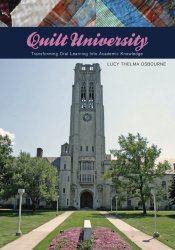$30.00
$30.00
(SAVE Now!)
as of 12/22/2024 (Details)
Quilt University crosses generic borders between memoir, literary criticism, and educational theory, with the intention of helping to transform the school experience for all those who have ever wondered if they belong in school and if they can succeed in school. Osbourne narrates her educational experiences, beginning with learning from family and community, and with attending segregated school in Evergreen, Alabama in the 1930s. She continues through business school to a career and having her own family in Toledo, Ohio, then returning to the University of Toledo to earn her Bachelors degree in Interdisciplinary Studies and Masters degree in Theory and Social Foundations of Education. In Quilt University, Osbourne describes and analyzes how "the dominant culture can keep you on the outside by not accepting your base of knowledge." She explains how she recognized and built upon her own base of knowledge, the quilting culture in which she grew up and which wraps around her throughout her life, in order to succeed in academics. In this way, her work is in the tradition of W.E.B. DuBois's "double consciousness" as described in The Souls of Black Folk. Osbourne cautions, "If individuals are to survive in the dominant culture and in Academic University, they need to rely on their inner voices and trust themselves and the universe as centers from which to speak, identify, and validate self." She explains that mentors with whom she could identify, whether met in daily life or through the pages of books, proved essential in developing that inner voice and identity. She introduces us to her mentors who include Alice Walker, Zora Neale Hurston, and Harriet Powers, as well as the quilters she meets everywhere she goes, and the scholars with whom she has worked and learned at conferences and in classrooms along the way. This book provides inspiration as well as practical advice for parents, teachers and administrators who want to help students learn in K-12 and postsecondary education, as well as for students who must take control of their own learning by recognizing and building upon the value of their own experiences and the knowledge they have inherited from family and community. Whereas Osbourne talks about her experiences as an African American woman, the notion of transforming academic learning by building on personal experience is equally relevant for any person, regardless of age, ethnicity or gender. Quilt University itself, as a book, is pieced together as one pieces together any work of creative art. Table of Contents: Piece #1: Introduction Piece #2: Learning Environments Piece #3: Early Thoughts Piece #4: What Is a Quilt? Piece #5: Crazy Quilt Piece #6: Patchwork Quilt Piece #7: Home and School Piece #8: My Grandfather Piece #9: Experience and Education Piece #10: Cut Off from Book Knowledge Piece #11: Entering Academic University Piece #12: Quilting Frames and Theoretical Frames Piece #13: Community in Quilt University and Lack of Community in Academic University Piece #14: The Quilt Connection Piece #15: Call-and-Response in Quilt University and Academic University Piece #16: Missing Pieces and Finding Pieces Piece #17: Why Life Stories of Quilters? Piece #18: Quilting History: Harriet Powers Piece #19: Quilting as Connecting: Renee Walton Piece #20: Quilting as Process: Alice Walker Piece #21: Zora Neale Hurston Piece #22: Conclusion: Piece Society Afterword: Piecing as Democratic Pedagogy (by Lynne Hamer)
Technical Details
No features available.